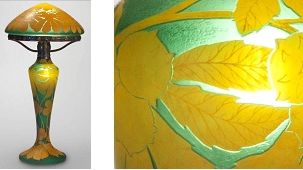
Press release -
New acquisition: Jugendstil lamp by Orrefors
Nationalmuseum has acquired a very rare Jugendstil table lamp from 1915. It is one of only two known objects designed by Axel Enoch Boman for Orrefors. The lamp can be seen in the exhibition Light and Darkness which runs until 3 February.
The mountings are in copper with relief decoration and the electric light, a modern item at the time, illuminates both the base and the shade. The glass shade has a green background with horse-chestnut leaves in orange overlay, and is signed “ORREFORS HW”. HW stands for Heinrich Wollman, who was a talented etcher fromAustria. The difficult glassblowing work was carried out by another important craftsman at the factory – Knut Bergqvist. At the time that the lamp was made, he was developing the overlay technique that came to be known as the Ariel technique.
Around the turn of the last century, Axel Enoch Boman (1875-1949)was employed at Kosta and then in 1903 at Reijmyre, tasked with engraving overlay glass with designs by Anna and Ferdinand Boberg, Alf Wallander and Gunnar G:son Wennerberg. He also produced such glass to his own designs and created sets of stemware. In 1915 he sent a number of overlay glass pieces to Orrefors. The acquired lamp is one of only two items designed by AE Boman for Orrefors that are known to still exist.
The Orrefors lamp has an interesting provenance. Consul Johan Ekman from Gothenburg bought Orrefors in 1913. His daughter Agnes Hellner wrote down the following comment: “At Christmas in 1915 the glassworks sent father a tall lamp, green with yellow horse-chestnut leaves in overlay glass. It was like nothing we had ever seen, and we thought it was so beautiful and so skilfully made, that we were overcome with wonder, joy, pride and even amazement that our dear Orrefors could achieve such a masterpiece.”
Nationalmuseum has few light fittings from the period when electricity was first introduced and started influencing the design of lamps. As electricity moved into homes, there were two different ideals. Either the naked bulb was kept visible to clearly display this innovation, or it was concealed. Designers Tiffany in the USA and Gallé in France used glass shades to spread a suggestive light. Other producers, including Orrefors, embraced the idea of enveloping the new electric light in glass.
This acquisition has been made possible with funding from BarbroOsher, through her Pro Suecia Foundation. It can be seen in Nationalmuseum’s exhibition Light and Darkness, which runs until 3 February 2013.
Further information
Micael Ernstell, curator applied art and modern design
micael.ernstell@nationalmuseum.se, +46 8 5195 4392
Hanna Tottmar, press officer
hanna.tottmar@nationalmuseum.se, +46 8 5195 4390, +46 767 23 46 32
Pressimages
www.nationalmuseum.se/pressroom
Categories

